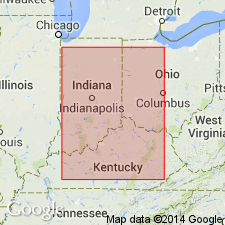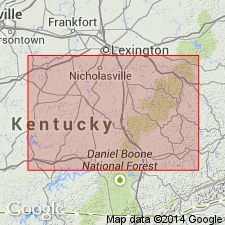
- Usage in publication:
-
- Gum Sulphur siltstone member
- Modifications:
-
- Named
- Dominant lithology:
-
- Siltstone
- Shale
- AAPG geologic province:
-
- Cincinnati arch
Summary:
Named Gum Sulphur siltstone member of New Providence Formation. Composed of brittle, shelly, resistant siltstone, roughly bedded. Where fresh, is light blue gray to drab. Taonurus is very prominent. Maximum exposed thickness is 40 ft. Occurs within the New Providence 35 to 40 above the base. Age is Early Mississippian. Occurs in Lincoln and Rockcastle Cos., KY.
Source: GNU records (USGS DDS-6; Reston GNULEX).

- Usage in publication:
-
- Gum Sulphur Bed*
- Modifications:
-
- Revised
- AAPG geologic province:
-
- Cincinnati arch
Summary:
Gum Sulphur siltstone member of New Providence formation of Stockdale (1939) revised as Gum Sulphur Bed of Nancy Member of Borden Formation. "It consists of ledge-forming spally weathering gray siltstone, and is gradational above and below into silty shale of the Nancy Member. As much as 80 ft thick but feathers out into the Nancy Member in all directions within 10 miles of Brodhead," Rockcastle Co., KY. Age is Early Mississippian.
Source: GNU records (USGS DDS-6; Reston GNULEX).
For more information, please contact Nancy Stamm, Geologic Names Committee Secretary.
Asterisk (*) indicates published by U.S. Geological Survey authors.
"No current usage" (†) implies that a name has been abandoned or has fallen into disuse. Former usage and, if known, replacement name given in parentheses ( ).
Slash (/) indicates name conflicts with nomenclatural guidelines (CSN, 1933; ACSN, 1961, 1970; NACSN, 1983, 2005, 2021). May be explained within brackets ([ ]).

